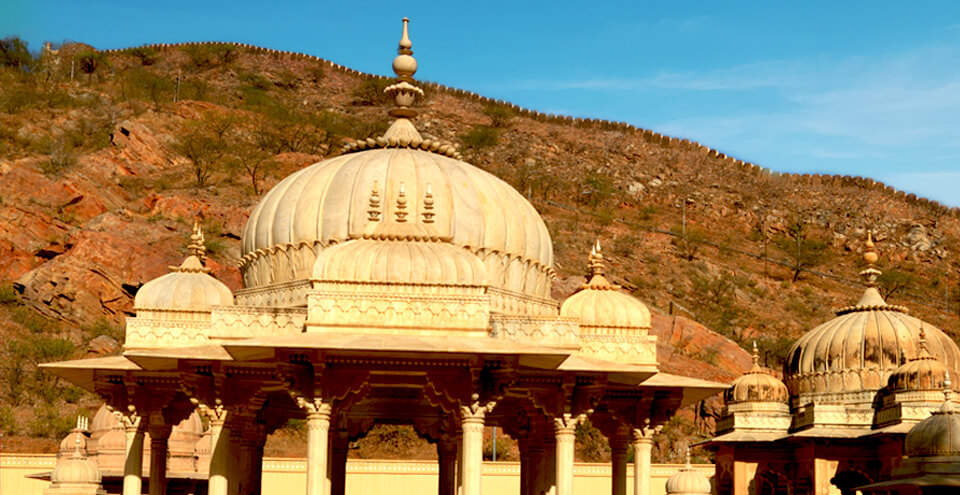
Maharani Ki Chhatri: The Majestic Memorials of Queens in Jaipur
Maharani Ki Chhatri, located in Jaipur, Rajasthan, is a stunning site that stands as a testament to the grandeur and architectural brilliance of the Rajput era. Known as the “Memorials of Queens,” this site consists of a series of intricately designed cenotaphs dedicated to the queens and royal women of the Kachwaha dynasty. In this blog post, we’ll delve into the historical significance, architectural features, and visitor experience associated with Maharani Ki Chhatri.
Overview of Maharani Ki Chhatri
1. Location and Setting
Maharani Ki Chhatri is situated in the heart of Jaipur, near the famous Amer Fort. The site is set amidst lush greenery and offers panoramic views of the surrounding landscape, including the majestic Amer Fort and the serene Aravalli hills. The tranquil environment adds to the historical and architectural charm of the memorials.
2. Historical Significance
Rajput Legacy: The cenotaphs at Maharani Ki Chhatri are dedicated to the queens and royal women of the Kachwaha dynasty, which ruled Jaipur for centuries. The site reflects the Rajput tradition of honoring and commemorating the royal women who played significant roles in the history of the kingdom.
Architectural Tribute: The cenotaphs are not only memorials but also architectural tributes to the royal women. They showcase the artistic and architectural achievements of the period, highlighting the craftsmanship and design sensibilities of the Rajput era.
Key Features of Maharani Ki Chhatri
1. Architectural Design
Cenotaphs (Chhatris): The site is renowned for its beautifully designed cenotaphs, or “chhatris,” which are ornate memorials built in honor of the queens. Each cenotaph features a distinctive dome (chhatri) supported by intricately carved pillars and adorned with exquisite stonework.
Intricate Carvings: The cenotaphs are decorated with intricate carvings and motifs, including floral patterns, geometric designs, and depictions of royal symbols. The craftsmanship reflects the high level of artistry and attention to detail characteristic of Rajput architecture.
Royal Symbolism: The design elements of the cenotaphs often include royal insignia and symbols, such as the Rajput crest, adding to their historical and cultural significance.
2. Historical Monuments
Royal Memorials: The memorials include those dedicated to various queens and royal women, each with its unique design and significance. The cenotaphs are built in a traditional style that combines elements of Hindu and Rajput architectural traditions.
Surrounding Gardens: The site is surrounded by well-maintained gardens and courtyards, enhancing the aesthetic appeal and providing a serene environment for visitors.
Visiting Maharani Ki Chhatri
1. Accessibility
Travel: Maharani Ki Chhatri is easily accessible from the main city of Jaipur. Visitors can reach the site by hiring a taxi or auto-rickshaw. It is located near Amer Fort, making it convenient to visit both sites in a single trip.
Local Attractions: While visiting Maharani Ki Chhatri, you can also explore other attractions in Jaipur, such as Amer Fort, the City Palace, and the Hawa Mahal.
2. Visiting Tips
Respect and Etiquette: As a historical and cultural site, it’s important to dress modestly and respect local customs. Maintain decorum while exploring the cenotaphs and surrounding areas.
Guided Tours: Hiring a local guide can enhance your visit by providing detailed insights into the history, architecture, and significance of the cenotaphs. Guides can also help you navigate the site and explain the various features.
Photography: Photography is generally allowed, but be mindful of any specific restrictions. Capture the intricate details of the carvings and the overall beauty of the memorials.
3. Best Time to Visit
Season: The ideal time to visit Maharani Ki Chhatri is from October to March when the weather is cooler and more comfortable for sightseeing. This period offers pleasant temperatures and clear skies for exploring the site.
Avoiding Heat: The summer months (April to June) in Rajasthan can be extremely hot, so visiting during the cooler season will make for a more enjoyable experience.
Maharani Ki Chhatri stands as a magnificent testament to the architectural and cultural heritage of the Rajput era. The intricately designed cenotaphs, with their ornate carvings and regal symbolism, provide a fascinating glimpse into the history and artistry of the Kachwaha dynasty. Whether you are interested in exploring historical monuments, admiring exquisite architecture, or simply enjoying the serene surroundings, Maharani Ki Chhatri offers a memorable and enriching experience in the heart of Jaipur.
